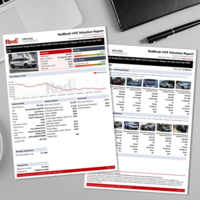The RedBook Insider: Used Vehicle Values Post-COVID: More Than Just a BEV Story
As the used vehicle market corrects from its pandemic-era highs, a closer look at segment-level performance reveals a more complex narrative than commonly portrayed. While battery electric vehicles (BEVs) have garnered headlines for rapid depreciation, they’re not the weakest performers. In fact, recent data shows premium SUVs have seen a steeper and more prolonged decline in retained value since their peak.
Our data shows the whole market saw significant appreciation between mid-2020 and early 2022, driven by supply shortages and heightened demand. BEVs and premium SUVs largely followed this trend. However, from early 2022 onwards, the decline began — and by early 2025, premium SUVs had lost more retained value, outpacing BEVs and the market average.

Source: RedBook
Several factors may explain this sharper downturn for premium SUVs. First, the segment faces structural headwinds: high fuel costs, tightening household budgets, and increased ownership expenses have softened demand. Meanwhile, OEMs have prioritized new model production in the SUV space, contributing to greater used supply and added pricing pressure.
In contrast, BEVs — while subject to technological disruption and OEM discounting — have shown more stable depreciation. Consumer interest in electrification continues to grow, supported by policy incentives and infrastructure improvements, although the latter being sluggish. As a result, BEVs are tracking closer to the broader market than many expected.
Looking ahead, international trade dynamics could introduce new volatility. The recent imposition of higher U.S. tariffs on Chinese-made electric vehicles, batteries, and related components in addition to many other countries levied not dissimilarly may reshape global supply chains. While Australia has not mirrored these tariffs, the global redistribution of vehicle supply — especially in EVs — could shift price dynamics here. For example, if Chinese manufacturers redirect inventory and production capacity from the U.S. to other markets like Australia, this could temporarily suppress BEV prices but increase availability and competition.
Consumer preference shifts are also at play. As alluded, cost of living pressures is seeing vehicle purchase aspirations realign, as buyers seek more affordable, more efficient, and increasingly hybridised powertrains. In parallel, a wave of premium SUVs taken on during COVID via lease and or fleets, whilst Australian’s had all this pent-up spending power, are now returning en-masse, flooding the used market, compounding depreciation.
The bottom line: BEVs are not the weakest link. In fact, the steepest corrections have occurred in legacy strongholds like premium SUVs. With global trade policies now in flux, local market watchers will need to keep an even closer eye on supply flows — and rethink assumptions about value retention.
Recent Posts
-
 The RedBook Insider: Emerging Divergence in the Popular 4x4 Ute Segment: Heavy-Duty Performance vs Hybrid-Electric Innovation30th September 2025
The RedBook Insider: Emerging Divergence in the Popular 4x4 Ute Segment: Heavy-Duty Performance vs Hybrid-Electric Innovation30th September 2025 -
 The RedBook Insider: Introducing RedBook LIVE: Smarter, Faster, and More Accurate Automotive Intelligence30th September 2025
The RedBook Insider: Introducing RedBook LIVE: Smarter, Faster, and More Accurate Automotive Intelligence30th September 2025 -
 The RedBook Insider: Introducing the RedBook Insider Webinar Series30th September 2025
The RedBook Insider: Introducing the RedBook Insider Webinar Series30th September 2025
